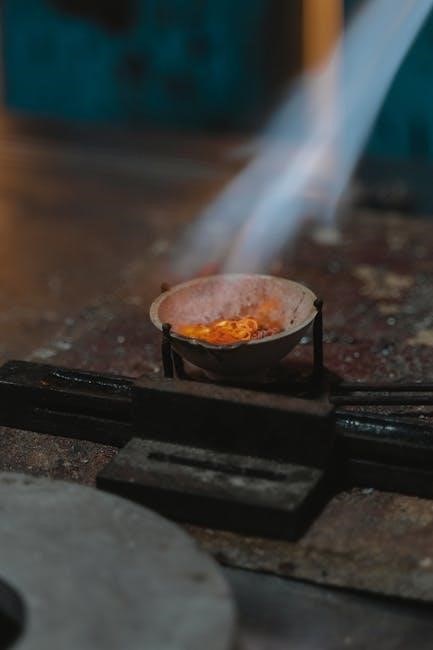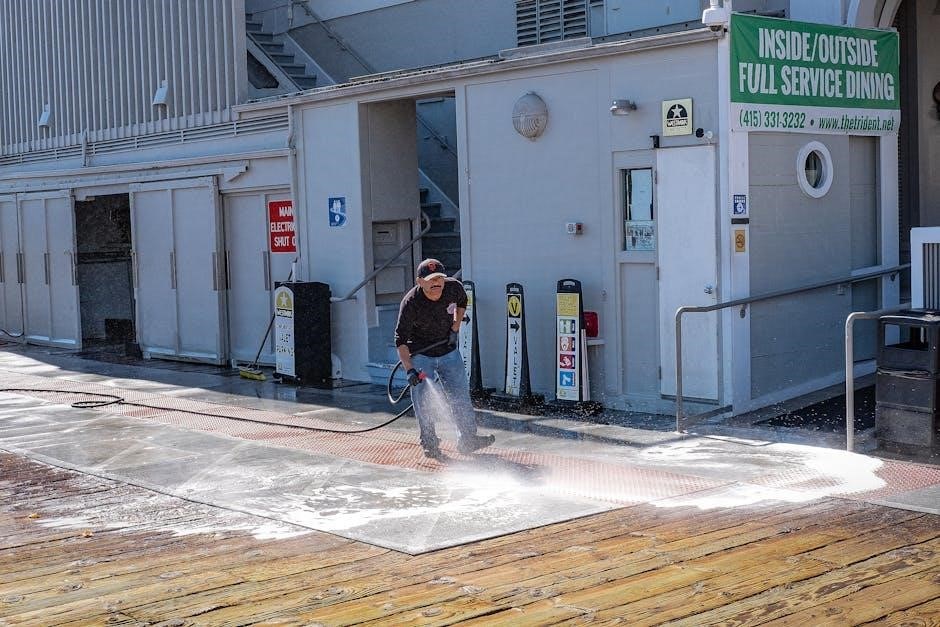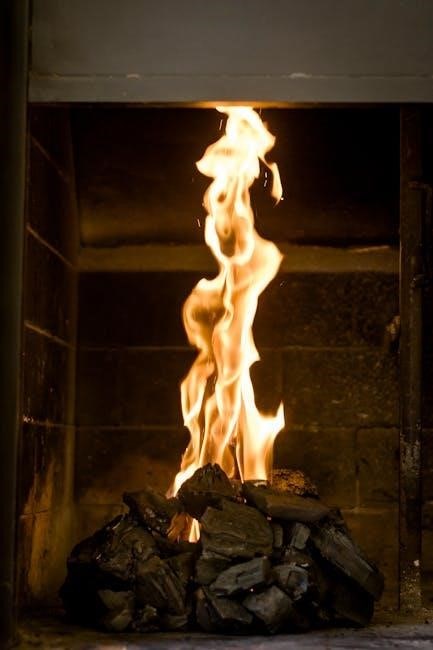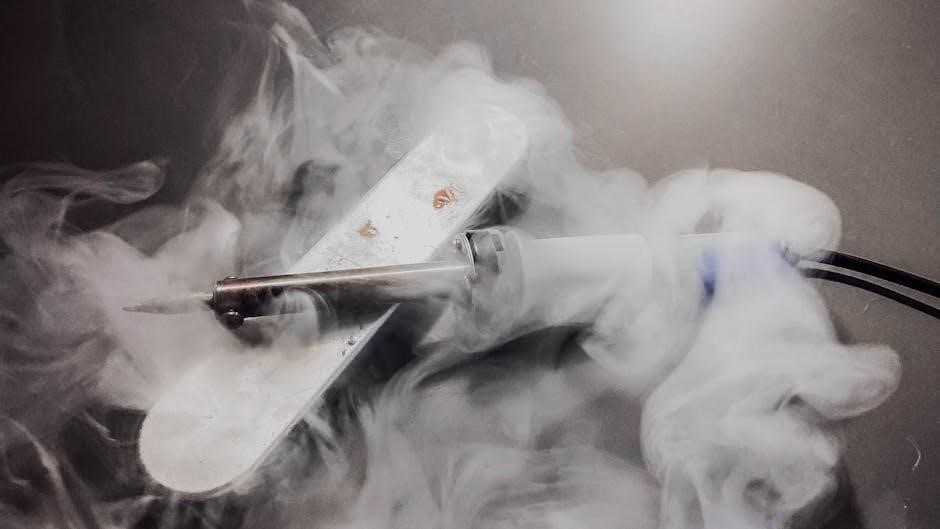Regular maintenance is essential for ensuring your hot tub remains safe, clean, and functional. A well-structured maintenance schedule helps preserve its longevity and performance, enhancing your relaxation experience.
1.1 Importance of Regular Maintenance
Regular maintenance is crucial for ensuring your hot tub operates efficiently, safely, and effectively. It prevents bacteria growth, extends equipment lifespan, and maintains water quality. Neglecting maintenance can lead to costly repairs, health risks, and reduced performance. Consistent upkeep ensures a clean, hygienic environment for relaxation and enjoyment, while also protecting your investment. A well-maintained hot tub enhances user experience and provides long-term satisfaction. Stay proactive to avoid issues and keep your hot tub in optimal condition year-round.
1.2 Benefits of a Well-Maintained Hot Tub
A well-maintained hot tub ensures cleanliness, safety, and optimal performance. Regular upkeep prevents bacterial growth, reduces chemical usage, and extends equipment lifespan. It also enhances relaxation, providing a hygienic and enjoyable experience. Proper maintenance prevents costly repairs, keeps water clear, and maintains heating efficiency. Consistent care also reduces the risk of mechanical failures and ensures all components function smoothly. By prioritizing maintenance, you create a safe, inviting environment for unwinding and entertaining, while protecting your investment for years to come.
1.3 Overview of the Maintenance Schedule
A well-organized maintenance schedule ensures your hot tub operates efficiently and safely. Tasks are divided into daily, weekly, monthly, quarterly, and annual routines. Daily checks involve cleaning and monitoring water levels, while weekly tasks focus on chemical balance and filter cleaning. Monthly maintenance includes deep cleaning and inspecting components. Quarterly and annual tasks involve draining, refilling, and professional servicing. Consistency is key to extending the lifespan of your hot tub and maintaining optimal performance. Customize the schedule based on usage for better results.
Understanding Your Hot Tub Components
Understanding your hot tub’s components is crucial for effective maintenance. Key parts include the pump, heater, jets, and control panel. Knowing their functions ensures proper care and optimal performance.
2.1 Key Parts of a Hot Tub
A hot tub consists of essential components, including the shell, jets, pump, motor, heater, filters, and control panel. The shell is the outer structure, while jets provide massage functionality. The pump and motor circulate water through the system, and the heater maintains desired temperatures. Filters ensure clean water, and the control panel manages settings. Understanding these parts is crucial for effective maintenance and troubleshooting, ensuring optimal performance and longevity of your hot tub.
2.2 Functions of Each Component
Each component of your hot tub plays a vital role in its operation. The pump circulates water, while the heater maintains temperature. Jets create soothing massage streams, and the filter ensures clean water. The control panel manages settings, and the plumbing system connects all parts. Understanding these functions helps you identify potential issues and perform targeted maintenance, ensuring optimal performance and longevity of your hot tub.
2.3 Manufacturer Recommendations
Always follow the manufacturer’s guidelines for your specific hot tub model. Refer to the user manual for tailored advice on cleaning, chemical usage, and part replacements. Use genuine parts to ensure compatibility and longevity. Regularly check for software updates if your hot tub has digital controls. Adhere to recommended maintenance schedules to prevent voiding warranties. Manufacturer recommendations are designed to optimize performance and safety, so they should be prioritized. Keep the contact information handy for any queries or professional assistance.

Daily Maintenance Tasks
Daily maintenance ensures your hot tub remains clean, safe, and functional; Key tasks include cleaning surfaces, checking water levels, and monitoring temperature settings regularly.
3.1 Cleaning the Hot Tub Surface
Cleaning the hot tub surface is a daily task to remove dirt, oils, and contaminants. Use a mild, non-abrasive cleaner and a soft, lint-free cloth or sponge. Avoid harsh chemicals or abrasive scrubbers, as they can damage the surface. Wipe down the shell, seats, and surrounds, paying attention to areas around jets and pillows. Regular cleaning prevents stains and maintains the tub’s appearance. For tougher stains, gently scrub with a soft-bristle brush. Rinse thoroughly and dry to prevent water spots. Consistency ensures a hygienic and inviting spa experience.
3.2 Checking Water Levels
Regularly checking the water level in your hot tub is crucial for optimal performance. The ideal level should be midway up the skimmer or filter compartment. Low water levels can damage the pump and heater, while excessive water may overflow during use. Always adjust the water level when adding or draining water. Consistent water levels ensure proper circulation and filtration, maintaining cleanliness and efficiency. This simple task prevents potential damage and keeps your hot tub running smoothly.
3.3 Monitoring Temperature Settings
Monitoring temperature settings is crucial for both safety and comfort. Most hot tubs operate between 98°F and 104°F, with 102°F being the recommended maximum. Always check the temperature before use to ensure it’s within a safe range. Use the control panel to adjust settings as needed, and consider lowering the temperature when the tub is not in use to conserve energy. Regular checks help prevent overheating or cooling issues, ensuring a relaxing and enjoyable experience every time.

Weekly Maintenance Schedule
Weekly tasks include testing pH levels, adjusting sanitizers, cleaning filters, and inspecting the skimmer basket to ensure clean, safe, and well-functioning water conditions consistently.
4.1 Testing and Adjusting pH Levels
Testing pH levels weekly ensures water safety and comfort. Use test strips or a digital tester to measure pH, aiming for a range of 7.2–7.8. If levels are too low, add a pH increaser; if too high, use a pH decreaser. Improper pH can cause eye irritation or damage equipment. Always follow product instructions for adjustments. Regular testing prevents imbalances and maintains sanitizer effectiveness, ensuring a safe and enjoyable soaking experience. Consistency is key for optimal hot tub performance and longevity.
4.2 Sanitizer Levels and Adjustments
Monitoring sanitizer levels is crucial for maintaining clean and safe water. Chlorine or bromine levels should be checked weekly, ideally between 1-3 ppm for chlorine and 3-5 ppm for bromine. Use test strips or kits for accuracy. Adjust levels by adding sanitizers as needed, ensuring proper dissolving to avoid overchlorination. Imbalanced sanitizer levels can lead to bacteria growth or skin irritation. Regular adjustments maintain water clarity and protect the hot tub system from contamination. Consistency is key to a safe and enjoyable soaking experience.
4.3 Cleaning the Filter
Cleaning the filter is a crucial weekly task to ensure optimal water circulation and cleanliness. Remove the filter and rinse it with a garden hose to eliminate debris. For deeper cleaning, soak it in a filter cleaner solution to break down stubborn contaminants. Rinse thoroughly and allow it to dry before reinstalling. Regular filter maintenance prevents clogging, improves water flow, and enhances the overall efficiency of your hot tub system. A clean filter also helps maintain balanced water chemistry and reduces the risk of bacterial growth.
4.4 Inspecting the Skimmer Basket
Regularly inspecting the skimmer basket is crucial for maintaining clean water. Remove and empty the basket weekly, ensuring it’s free from debris. Check for tears or damage that might reduce its efficiency. Clean the basket with a mild detergent if necessary. A well-maintained skimmer basket improves water circulation and filtration, preventing contaminants from re-entering the hot tub. Replace it as recommended by the manufacturer to ensure optimal performance and hygiene.

Monthly Maintenance Tasks
Perform deeper cleaning, inspect and replace filters, check the pump and motor, and lubricate moving parts to ensure optimal performance and longevity of your hot tub.
5.1 Deep Cleaning the Hot Tub
Deep cleaning involves thoroughly sanitizing and scrubbing all surfaces, including the shell, seats, and jets. Begin by draining the water and wiping down surfaces with a mild cleaner. Pay attention to crevices and areas prone to algae buildup. Use a soft brush to scrub away stubborn stains or mineral deposits. Rinse the tub thoroughly before refilling. This process ensures a clean, hygienic environment and prevents the growth of bacteria or mold. Regular deep cleaning is essential for maintaining water quality and longevity. Always follow manufacturer guidelines for cleaning products to avoid damage. Deep cleaning should be done monthly or more frequently if heavily used. By maintaining a pristine hot tub, you ensure a relaxing and safe experience for everyone. Consistency is key to preserving its condition and performance over time. A well-maintained hot tub not only lasts longer but also enhances your overall enjoyment. Remember, a clean hot tub is a healthy and inviting space for recreation and relaxation. Regular deep cleaning is a simple yet effective way to protect your investment and ensure optimal functionality. This routine task is vital for any hot tub owner looking to maintain a luxurious and safe soaking experience. Deep cleaning also helps identify potential issues early, preventing costly repairs. It’s a proactive step toward extending the life of your hot tub and keeping it in excellent condition. Always prioritize deep cleaning as part of your monthly maintenance schedule to enjoy your hot tub year-round. This practice ensures your hot tub remains a clean, safe, and enjoyable space for years to come.
5.2 Checking and Replacing Filters
Regularly inspecting and replacing your hot tub filters is essential for maintaining clean and safe water. Check filters monthly and clean them as needed. Replace filters every 1-2 years or as recommended by the manufacturer. Dirty or worn-out filters can reduce water circulation, decrease efficiency, and lead to poor water quality. Proper filter maintenance ensures optimal performance, prevents damage to the pump, and keeps your hot tub running smoothly. Always use high-quality replacement filters designed for your specific model.
5.3 Inspecting the Pump and Motor
Inspecting the pump and motor is crucial for ensuring optimal performance. Check for signs of wear, such as leaks, corrosion, or unusual noises. Verify that all connections are secure and functioning properly. Look for any blockages in the impeller or intake valves, as these can reduce efficiency. Ensure the motor is running smoothly and within the recommended voltage range. If you notice any issues, address them promptly to prevent further damage. Regular inspections can extend the lifespan of these critical components.

5.4 Lubricating Moving Parts
Lubricating moving parts is crucial for smooth operation and longevity. Regularly apply silicone-based lubricant to jets, valves, and other movable components to prevent friction and wear. Inspect for signs of wear or corrosion during application. This simple step ensures optimal performance and extends the lifespan of your hot tub’s mechanical systems. Always follow the manufacturer’s recommendations for suitable lubricants.

Quarterly Maintenance
Quarterly maintenance involves draining and refilling the hot tub, cleaning jets, and inspecting plumbing. It also includes checking the heater and electrical components to ensure optimal functionality.
6.1 Draining and Refilling the Hot Tub
Draining and refilling your hot tub quarterly is crucial for maintaining water quality and hygiene. Over time, contaminants and chemicals can build up, affecting both the water and the system. Start by turning off the power and attaching a drain hose to the valve. Allow the water to drain completely, then rinse the tub thoroughly. Before refilling, clean any visible stains or debris. Use a test strip to ensure the new water meets safety standards. Always dispose of old water responsibly to avoid environmental harm.
6.2 Cleaning the Jets and Plumbing
Cleaning the jets and plumbing is crucial for maintaining water flow and hygiene. Use a jet cleaning product to remove mineral buildup and debris. Run the cleaner through the system as per instructions, then flush thoroughly. This process ensures optimal jet performance and prevents clogs. Regular cleaning enhances water circulation, improving efficiency and overall hot tub experience. Always follow manufacturer guidelines for the best results and to maintain warranty conditions.
6.3 Inspecting the Heater and Electrical Components
Inspecting the heater and electrical components is crucial for ensuring safety and efficiency. Check for wear, damage, or corrosion on wires, connections, and the heating element. Verify that all electrical parts are securely fastened and functioning properly. Look for signs of overheating or leakage, which could indicate potential hazards. Ensure the heater is operating within the recommended temperature range. If any issues are found, consult a professional to avoid electrical risks and maintain optimal performance. Regular inspections prevent costly repairs and enhance overall safety.

Annual Maintenance Tasks
Annual maintenance ensures your hot tub operates efficiently and safely. It involves thorough inspections, replacing worn parts, and professional checks to maintain optimal performance and longevity.
7.1 Full System Inspection
A full system inspection involves examining every component of your hot tub to ensure optimal functionality. Check the heater, jets, pumps, and electrical connections for any signs of wear or damage. Inspect the tub’s structure for cracks or leaks and verify that all safety features are functioning correctly. This comprehensive check helps identify potential issues before they escalate, ensuring your hot tub operates safely and efficiently. It’s recommended to perform this inspection annually or hire a professional if unsure.
- Examine heater and pump performance.
- Check electrical connections and components.
- Inspect the tub’s shell and plumbing for leaks.
- Ensure all safety features are operational.
7.2 Replacing Wear and Tear Parts
Regularly replacing worn-out parts ensures optimal hot tub performance and safety. Components like seals, gaskets, jets, and the cover may degrade over time. Inspect these parts annually for cracks, leaks, or reduced efficiency. Replace them promptly to prevent further damage or costly repairs. Refer to your manufacturer’s guidelines for recommended replacement intervals. Addressing wear and tear proactively extends the lifespan of your hot tub and maintains its functionality.Keep your hot tub in peak condition by staying vigilant about part replacements.
7.3 Professional Servicing Recommendations
Annual professional servicing is crucial for maintaining your hot tub’s optimal performance. Certified technicians can identify potential issues before they escalate, ensuring safety and efficiency. They inspect electrical components, plumbing, and heating systems, while also verifying the integrity of seals and jets. Professional servicing extends the lifespan of your hot tub and prevents costly repairs. Schedule these check-ups to keep your spa running smoothly and safely, allowing you to enjoy uninterrupted relaxation and entertainment.

Troubleshooting Common Issues
Identify and address common hot tub problems promptly to prevent system damage. Regular checks and quick fixes can resolve issues like leaks, heating malfunctions, and cloudy water effectively.
8.1 Identifying and Fixing Leaks
Leaks are common hot tub issues that can wasting water and damage components. Start by visually inspecting hoses, connections, and jets for water droplets or puddles. Turn off the power, drain the water to the appropriate level, and pressurize the system to locate the source. Common causes include worn seals, loose fittings, or cracked pipes. Fix minor leaks by replacing worn-out gaskets or resealing surfaces. For major issues, consult a professional to avoid further damage and ensure safety.
8.2 Resolving Heating Issues
Heating issues in hot tubs often arise from faulty thermostats, clogged filters, or malfunctioning heaters. Start by checking the power supply and thermostat settings. Ensure proper water circulation by cleaning filters and inspecting pipes for blockages. If the heater doesn’t activate, test the high-limit switch or reset it if necessary. For persistent problems, inspect heating elements for corrosion or damage. Consult a professional if issues persist, as internal electrical components may require specialized attention to ensure safe and efficient operation.
8.3 Addressing Cloudy or Discolored Water
Cloudy or discolored water in your hot tub can be caused by improper pH levels, insufficient sanitizer, or clogged filters. To resolve this, test and adjust the pH and sanitizer levels. Clean or replace the filter if necessary. Shocking the water with an oxidizer can also help eliminate contaminants. Regularly monitoring water clarity and addressing issues promptly ensures a clean and safe soaking experience. Always follow manufacturer guidelines for chemical usage and maintenance procedures.

Safety Precautions During Maintenance
Always disconnect power before maintenance. Wear gloves and goggles when handling chemicals. Ensure the area is clear of water to prevent slips. Follow all safety guidelines strictly.
9.1 Electrical Safety Guidelines
Always turn off the power supply before performing any maintenance tasks. Use Ground Fault Circuit Interrupter (GFCI) protected outlets to prevent electrical shocks. Never submerge electrical components in water or touch them with wet hands. Keep the area around electrical controls dry to avoid short circuits. Avoid using electrical appliances near the hot tub. Regularly inspect cords and connections for damage. If unsure about any electrical issue, consult a licensed professional to ensure safety and compliance with local regulations.
9.2 Chemical Handling Safety
Always wear gloves and goggles when handling chemicals to prevent skin and eye irritation. Read labels carefully and follow instructions for proper dosing. Store chemicals in a cool, dry place, out of reach of children. Never mix chemicals, as this can create dangerous reactions. Ensure good ventilation when applying chemicals to avoid inhaling fumes. Dispose of empty containers and spills according to safety guidelines to maintain a safe environment for everyone using the hot tub.
9.3 Preventing Slips and Falls
To ensure safety, always maintain a clean and dry surrounding area around your hot tub. Use non-slip mats or surfaces near the tub to prevent accidents. Keep the area well-lit to improve visibility, especially at night. Regularly inspect the hot tub steps and surfaces for wear and tear, and replace any damaged parts promptly. Avoid using electrical appliances near water, and keep emergency aids like a first-aid kit nearby. Properly securing the cover when not in use also helps prevent unintended access and potential falls.

Creating a Personalized Maintenance Schedule
Creating a personalized maintenance schedule ensures tasks are tailored to your hot tub’s specific needs and usage patterns, promoting consistency and accountability for optimal care and enjoyment.
10.1 Customizing Based on Usage
Customizing your maintenance schedule based on usage ensures efficiency and effectiveness. For light use, reduce the frequency of cleaning and chemical checks. For heavy use, increase the frequency of water testing, filter cleaning, and surface sanitizing. Adjust the deep cleaning and replacement of parts according to how often the hot tub is used. This personalized approach helps maintain optimal conditions and extends the lifespan of your hot tub. Regular adjustments ensure the schedule remains relevant and effective over time.
- Light use: Less frequent maintenance tasks.
- Moderate use: Standard maintenance schedule.
- Heavy use: Increased frequency of key tasks.
10.2 Setting Reminders and Alerts
Setting reminders and alerts is crucial for staying on track with your hot tub maintenance schedule. Use digital calendars, apps, or maintenance management tools to schedule tasks like water testing, cleaning, and filter changes. Set recurring alerts for daily, weekly, and monthly chores to ensure consistency. Additionally, consider setting reminders for ordering supplies or scheduling professional services. This proactive approach helps prevent overlooked tasks and keeps your hot tub in optimal condition year-round.
10.3 Tracking Maintenance History
Keeping a detailed record of your hot tub maintenance activities is crucial for long-term care. Use a digital app, spreadsheet, or physical log to document tasks like cleaning, chemical adjustments, and part replacements. This helps identify trends, ensures consistency, and prolongs equipment lifespan. Regularly reviewing your maintenance history allows you to anticipate future needs and avoid potential issues. Over time, this record becomes an invaluable resource for optimizing your hot tub’s performance and ensuring it remains in peak condition.
Additional Resources for Hot Tub Maintenance
Explore recommended tools, cleaning supplies, and downloadable checklists to streamline your maintenance routine and ensure your hot tub stays in optimal condition year-round.
11.1 Recommended Maintenance Tools
Essential tools for effective hot tub maintenance include pH test strips, a skimmer net, filter cleaning brush, and a thermal cover. Additional tools like a vacuum cleaner, chemical feeder, and pliers can also be useful. These tools help monitor water quality, clean surfaces, and ensure proper functionality. Regularly checking and using these tools will make maintenance easier and more efficient. Always keep them nearby for quick access and to maintain your hot tub in optimal condition year-round.
11.2 Suggested Cleaning Products
For effective hot tub maintenance, use high-quality cleaning products specifically designed for spas. Clarifiers help remove impurities, while shock treatments eliminate contaminants. Enzyme-based cleaners break down organic matter, and tile and vinyl cleaners prevent staining. pH balancers ensure water safety, and filter cleaners maintain optimal circulation. Always choose products compatible with your hot tub type and follow manufacturer instructions for best results. Regular use of these products will keep your hot tub clean, hygienic, and ready for enjoyable use year-round.
11.3 Downloadable Maintenance Checklists
Downloadable maintenance checklists are invaluable tools for keeping your hot tub in prime condition. These checklists provide a structured approach to tracking daily, weekly, and monthly tasks. They ensure no essential maintenance steps are overlooked, helping you stay organized and consistent. Many checklists are available in PDF format, offering convenience and portability. You can customize them based on your hot tub’s specific needs and usage patterns. Regular use of these checklists will help prolong the lifespan of your hot tub and maintain its performance. They are easily accessible online, often provided by manufacturers or maintenance experts, making it simple to adopt a proactive approach to hot tub care.
Regular maintenance is key to your hot tub’s longevity and safety. Consistent care ensures optimal performance, enhancing relaxation and hygiene. Stay consistent and enjoy your spa!
12.1 Summarizing the Importance of Maintenance
Regular maintenance ensures your hot tub remains safe, clean, and functional. It prevents bacterial growth, extends equipment lifespan, and maintains optimal water quality. Consistent upkeep also enhances energy efficiency and prevents costly repairs. By following a structured maintenance schedule, you protect your investment and ensure a relaxing, hygienic experience for years to come. Neglecting maintenance can lead to premature wear, unsafe conditions, and reduced performance, making routine care essential for long-term enjoyment.
12.2 Encouraging Consistency in Maintenance
Consistency is key to maintaining your hot tub’s optimal condition. Regular checks and adherence to a schedule prevent issues before they arise. By prioritizing routine tasks, you ensure a safe, clean, and enjoyable experience. Set reminders, keep a maintenance log, and make it a habit to inspect and clean regularly. Consistency not only extends the lifespan of your hot tub but also enhances your relaxation and enjoyment. Stay committed to your maintenance routine for long-term benefits and peace of mind.
12.3 Final Tips for Enjoying Your Hot Tub
Consistency is key to maximizing your hot tub experience. Always follow your maintenance schedule to ensure safety and comfort. Experiment with different jet settings and temperatures to personalize your relaxation. Consider adding soothing music or dim lighting to enhance ambiance. Most importantly, carve out time to unwind and recharge, making your hot tub a sanctuary for mental and physical well-being. Regular upkeep will keep it a haven for years to come.





